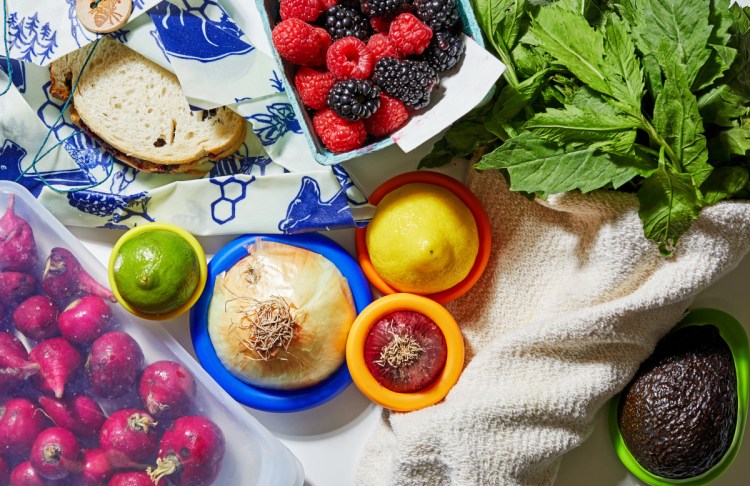I’m a plastic addict. I fill gallon-size zip-top freezer bags with tomato sauce bound for the freezer and snack-size bags with cashews bound for my purse. I stretch plastic wrap over a Key lime pie I plan to nibble on later. My husband, meanwhile, seems to pull off several feet of aluminum foil just to wrap a sliver of lime. I find these treasures littering the back of the refrigerator and wonder why it was necessary to enshroud this bite of food instead of just, you know, eating it. I have also stumbled upon plastic sandwich bags filled with some slimy remnant I had tucked into the vegetable crisper months earlier, a bit of onion or half a blood orange I had meant to use.
I recently decided I’d had enough – and probably the planet had, too. According to marine research organization Algalita, Americans throw out 185 pounds of plastic per person each year, and National Geographic reported in 2017 that just 9 percent of all plastic worldwide is recycled. The first plastic sandwich bags were introduced in 1957, well before I was born, meaning that I honestly don’t know what it’s like to live without them.
I’m actually a bit of a reduce/reuse/recycle weirdo. One of those plastic gallon bags in my freezer is kept filled with kitchen scraps that I regularly turn into vegetable broth. I compost my garden waste, own Tupperware that may date to the Clinton presidency and even adopted my grandmother’s Depression-era habit of turning remnants of bar soap into liquid soap. I’m not bad at recycling, but my plastic addiction seemed unseemly.
While I try to wash and reuse plastic bags as much as I can, the obvious solution was to figure out how to reduce our dependence on plastic, and aluminum. Turns out, it’s not as hard as I thought, but reducing wasn’t the only answer. I also needed to rethink how we shopped for, cooked and stored our food. I call it our “mindful kitchen.” (I can’t remember the last time I used a plastic zip-top bag, although I did find half a tomato swathed in a yard of foil the other day. Words were spoken.)
Here are some ways you can create a more environmentally friendly kitchen:
• SHOP MORE OFTEN: Buying in bulk can lead to unintentional food waste. Instead of planning a week’s worth of family meals as I used to, I now shop for groceries almost every day. It’s not an American approach, perhaps, but it works for me because I live in an urban area populated with large grocery stores, corner bodegas and several farmers markets, all within walking distance.
• CONSIDER A ZERO-WASTE OPTION: If you want to do a better job of recycling items that aren’t accepted by your local facility, from plastic spatulas to bottle caps to water filters, consider TerraCycle’s pack-and-ship “kitchen separation zero waste box.” The boxes can be purchased in different sizes (you can reduce the cost by splitting it with neighbors or co-workers) and, upon receipt, the company will melt metals for recycling and extrude and pelletize plastics to be remolded into new plastic products.
• CLEAN OUT YOUR PANTRY: Because I live in a fairly humid area, I tended to store items such as dry cereal and nuts in the refrigerator to help maintain their freshness. T-fal’s Ingenio Dry Storage containers, which are airtight and stackable, freed up space in the fridge without cluttering up my cupboards.
• GO FOR THE BEESWAX: Bee’s Wrap, Abeego and Etee are reusable food wraps primarily made of fabric coated in beeswax. Once you get used to using them, they work really well, and can be washed in cold water (hot water would melt the wax); the tricky part is remembering that the sticky fabric will not actually stick to the surface of, for instance, a glass bowl – simply mold the fabric around the top and sides of the bowl, folding the edges of the fabric so that they stick together to form a sturdy seal. If there’s a downside, it’s that I can’t see through the wrap to know what’s inside, but that’s nothing a stick-on label couldn’t fix.
• USE PLASTIC SANDWICH AND STORAGE BAG ALTERNATIVES: The beeswax-coated food wraps definitely work well for sandwiches, but Stasher’s reusable silicone bags made my heart skip a beat. Made of clear food-grade silicone (I can see inside!), the airtight bags come in a variety of options, from snack size up to a half-gallon, and can safely go from fridge to freezer to stovetop to microwave to oven. The bags are dishwasher-safe.
• IMPROVE YOUR FRESH FOOD STORAGE: Food Huggers are disks of food-grade silicone that simply slip over the cut ends of lemons, onions, apples, salami and so forth to prevent them from drying out – an eminently practical solution to food storage, and there’s even an avocado-shaped version. For storing greens and herbs, Vejibags are organic cotton bags that you dampen slightly, then fill with produce to store in the crisper drawers of the refrigerator; just dampen the bag again whenever it starts to dry out, and the leafy goods inside will stay fresh for weeks.
• SWITCH TO BAMBOO: My paper towel habit was nearly as bad as my plastic bag habit, but a roll of bamboo paper towels that I spotted in my local natural foods store changed everything. The perforated towels look and feel just like a slightly thicker version of the traditional variety, but each sheet can be used up to 100 times, simply by rinsing it out and letting it air-dry. Bamboo paper towels are highly sustainable, and the bamboo fibers are said to break down quickly – as fast as 45 days in a landfill. NatureZway, Caboo and Bambooee are a few widely available brands.
Send questions/comments to the editors.



Comments are no longer available on this story